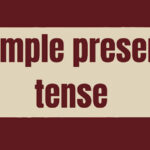Past perfect tense is a grammatical tense used to describe an action that occurred before another action in the past.
It is formed by using the auxiliary verb “had” followed by the past participle of the main verb.
The structure of the past perfect tense is as follows:
Subject + had + past participle of the verb
For example:
1. She had already finished her homework before she went to bed.
In this sentence, the action of finishing homework (past perfect) occurred before the action of going to bed (simple past).
2. They had lived in that house for ten years before they moved to a new city.
Here, the action of living in the house (past perfect) took place before the action of moving to a new city (simple past).
The past perfect tense is used to establish a clear sequence of events in the past, indicating that one action was completed before another.
It is often used in storytelling, recounting events, or discussing the past in relation to another past action.
Here are five examples of sentences using the past perfect tense:
1. Sarah had already left the party when I arrived.
The action of Sarah leaving the party (past perfect) happened before the action of my arrival (simple past).
2. By the time we reached the cinema, the movie had already started.
The action of the movie starting (past perfect) occurred before the action of our arrival at the cinema (simple past).
3. He had finished his presentation before the audience arrived.
Here, the action of finishing the presentation (past perfect) took place before the action of the audience arriving (simple past).
4. The train had departed by the time we reached the station.
The action of the train departing (past perfect) happened before the action of our arrival at the station (simple past).
5. They had eaten dinner before they went to the concert.
In this sentence, the action of eating dinner (past perfect) occurred before the action of going to the concert (simple past).
In each of these examples, the past perfect tense is used to indicate that an action was completed before another action in the past.
STRUCTURE OR FORMULA
The formula or structure of the past perfect tense is as follows:
Subject + had + past participle of the verb
The subject is the person or thing performing the action.
“Had” is the auxiliary verb used to indicate the past perfect tense.
The past participle of the verb is the form of the verb that typically ends in “-ed” for regular verbs, but irregular verbs have their own specific forms.
Here are a few examples of the structure of the past perfect tense:
– I had finished my work.
– She had studied for the exam.
– They had already left.
– He had eaten breakfast.
In these examples,
the auxiliary verb “had” is used before the past participle of the main verb (e.g., finished, studied, left, eaten) to form the past perfect tense.
Here’s a breakdown of the structure of the past perfect tense in positive, negative, and interrogative forms:
Positive Form:
Subject + had + past participle of the verb
– I had finished my work.
– She had studied for the exam.
– They had already left.
– He had eaten breakfast.
Negative Form:
Subject + had not (hadn’t) + past participle of the verb
– I hadn’t finished my work.
– She hadn’t studied for the exam.
– They hadn’t already left.
– He hadn’t eaten breakfast.
Interrogative Form:
Had + subject + past participle of the verb?
– Had I finished my work?
– Had she studied for the exam?
– Had they already left?
– Had he eaten breakfast?
In the positive form, we use the auxiliary verb “had” followed by the past participle of the verb.
In the negative form, “had not” (or the contraction “hadn’t”) is placed between the subject and the past participle.
In the interrogative form, the auxiliary verb “had” is placed at the beginning of the sentence, before the subject, and a question mark is added at the end.
RULES
Here are some key rules for using the past perfect tense:
1. Past Action Before Another Past Action:
The past perfect tense is used to indicate that an action occurred before another past action.
It establishes a clear sequence of events in the past.
Example: She had already finished her homework before she went to bed.
2. Formation:
The past perfect tense is formed by using the auxiliary verb “had” followed by the past participle of the main verb.
Example: They had lived in that house for ten years before they moved to a new city.
3. Emphasizing Duration:
The past perfect tense can be used to emphasize the duration of an action that took place before another action in the past.
Example: He had been studying English for three years before he traveled to the United States.
4. Use of Time Expressions:
Time expressions such as “before,” “by the time,” “already,” and “until” are often used with the past perfect tense to indicate the relationship between two past actions.
Example: By the time we reached the cinema, the movie had already started.
5. Narration and Storytelling:
The past perfect tense is commonly used in storytelling
6. Sequence of events in the past:
The past perfect tense is used to establish the order of events in the past, indicating that one action happened before another action.
Example: She had already left when I arrived at the party.
Remember that the past perfect tense is used to indicate an action that occurred before another action in the past, providing a clear temporal relationship between the two actions.
HOW TO EXPLAIN PAST PERFECT TENSE TO STUDENTS
When explaining the past perfect tense to students, it can be helpful to use simple language and provide clear examples. Here’s an approach you can take:
1. Start with the basic concept:
Explain that the past perfect tense is used to talk about an action that happened before another action in the past.
Emphasize that it helps establish the order of events in the past.
2. Use a timeline:
Draw a timeline on the board or provide a visual aid to illustrate the sequence of events.
Point out that the past perfect tense is used to talk about something that happened further back in the past, while another action occurred later.
3. Explain the structure:
Introduce the structure of the past perfect tense, which is “had + past participle of the verb.” Explain that “had” is the auxiliary verb used to indicate the past perfect tense, and the past participle of the main verb follows it.
4. Provide examples:
Offer simple examples to demonstrate the usage of the past perfect tense.
Use relatable situations or stories that the students can understand.
For example:
– “Sarah had finished her homework before she went to bed.”
– “The train had already left when they arrived at the station.”
5. Highlight time expressions:
Explain that time expressions like “before,” “after,” “already,” and “by the time” often accompany the past perfect tense to show the relationship between the two past actions.
6. Practice exercises:
Provide practice exercises or worksheets for the students to reinforce their understanding. Include sentences where they need to form the past perfect tense based on the given context or rewrite sentences using the past perfect tense.
7. Encourage speaking and writing practice:
Engage the students in speaking and writing activities that require them to use the past perfect tense.
Provide prompts or ask questions that prompt them to use the tense correctly.
8. Review and provide feedback:
Review the students’ work, correct any errors, and provide feedback to help them improve their understanding and usage of the past perfect tense.
Remember to keep the explanations clear and concise, and provide plenty of examples and practice opportunities to help the students grasp the concept of the past perfect tense.
Exercise:
Rewrite the following sentences using the past perfect tense.
1. She finished her work before going on vacation.
2. They had breakfast before leaving the house.
3. He washed the dishes before going to bed.
4. We visited the museum before it closed.
5. She bought groceries before cooking dinner.
6. They finished the project before the deadline.
7. He read the book before watching the movie adaptation.
8. We cleaned the house before the guests arrived.
9. She wrote the email before going to the meeting.
10. They watched the trailer before seeing the movie.
Answers:
1. She had finished her work before going on vacation.
2. They had had breakfast before leaving the house.
3. He had washed the dishes before going to bed.
4. We had visited the museum before it closed.
5. She had bought groceries before cooking dinner.
6. They had finished the project before the deadline.
7. He had read the book before watching the movie adaptation.
8. We had cleaned the house before the guests arrived.
9. She had written the email b
efore going to the meeting.
10. They had watched the trailer before seeing the movie.
In each of these sentences, the past perfect tense is used to indicate that an action occurred before another action in the past.
Learn more Tenses
- Simple present tense
- Simple past tense
- Simple future tense
- Present progressive tense
- Past progressive tense
- Future progressive tense
- Present perfect tense
- Future perfect tense
- Present perfect continuous tense
- Past perfect continuous tense
- Future perfect continuous tense
- Tenses in English grammar





1 thought on “Past Perfect Tense”